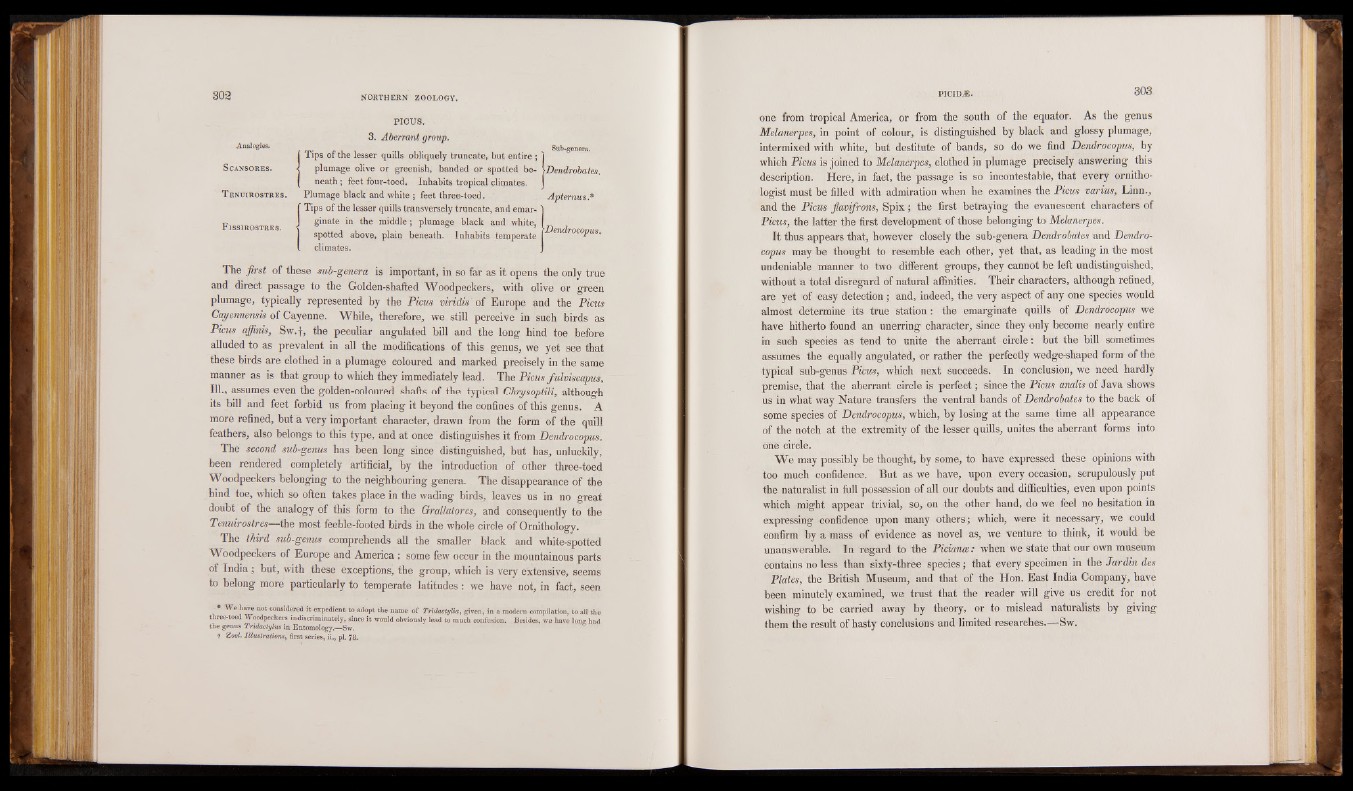
FICUS.
Analogies.
SCANSORES.
T en u ir o s t r e s .
F iss ir o s t r e s .
3. Aberrant group.
{ Tips of the lesser quills obliquely truncate, but entire ;
plumage olive or greenish, banded or spotted beneath;
feet four-toed. Inhabits tropical clirjiates.
Plumage black and white ; feet three-toed,
f Tips of the lesser quills transversely truncate, and emar-
ginate in the middle; plumage black and white,
I spotted above, plain beneath. Inhabits temperate
I climates.
Sub-genera.
Dendrobates.
Aptemus.*
j-Dendroeopus.
The first of these sub-genera is important, in so far as it opens the only true
and direct passage to the Golden-shafted Woodpeckers, with olive or green
plumage, typically represented by the Pious viridis' of Europe and the Pirns
Cayennensis of Cayenne. While, therefore, we still perceive in such birds as
Pious affinis, Sw.f, the peculiar angulated bill and the long hind toe before
alluded to as prevalent in all the modifications of this genus, we yet see that
these birds are clothed in a plumage coloured and marked precisely in the same
manner as is that group to which they immediately lead. The Picus fulviscapus, 111., assumes even the golden-coloured shafts of the typical Chrysoptili, although
its bill and feet forbid us from placing it beyond the confines of this genus. A
more refined, but a very important character, drawn from the form of the quill
feathers, also belongs to this type, and at once distinguishes it from Dendrocopus. The second sub-genus has been long since distinguished, but has, unluckily,
been rendered completely artificial, by the introduction of other three-toed
Woodpeckers belonging to the neighbouring genera. The disappearance of the
hind toe, which so often takes place in the wading birds, leaves us in no great
doubt of the analogy of this form to the Grallatares, and consequently to the
Tenuirostres—the most feeble-footed birds in the whole circle of Ornithology.
The third sub-genus comprehends all the smaller black and white-spotted
Woodpeckers of Europe and America : some few occur in the mountainous parts
of India; but, with these exceptions, the group, which is very extensive, seems
to belong more particularly to temperate latitudes: we have not, in fact, seen
* Wehave not considered it expedient to adopt the name of T r i d a c t y lia , given, in a modern compilation, to all th e three-toed Woodpeckers indiscriminately, since it would obviously lead to much confusion. . Besides,the genus T r id a c t y lu s in Entomology.—Sw. we have long had f Z o o l. I ll u s t r a t io n s , first series, ii., pi. 78.
one from tropical America, or from the south of the equator. As the genus
Melanerpes, in point of colour, is distinguished by black and glossy plumage,
intermixed with white, but destitute of bands, so do we find Dendrocopus, by
which Picus is joined to Melanerpes, clothed in plumage precisely answering this
description. Here, in fact, the passage is so incontestable, that every ornithologist
must be filled with admiration when he examines the Picus varius, Linn.,
and the Picus flamfrons, Spix; the first betraying the evanescent characters of
Picus, the latter the first development of those belonging to Melanerpes. It thus appears that, however closely the sub-genera Dendrobates and Dendrocopus
may be thought to resemble each other, yet that, as leading in the most
undeniable manner to two different groups, they cannot be left undistinguished,
without a total disregard of natural affinities. Their characters, although refined,
are yet of easy detection; and, indeed, the very aspect of any one species would
almost determine its true station : the emarginate quills of Dendrocopus we
have hitherto found an unerring character, since they only become nearly entire
in such species as tend to unite the aberrant circle: but the bill sometimes
assumes the equally angulated, or rather the perfectly wedge-shaped form of the
typical sub-genus Picus, which next succeeds. In conclusion, we need hardly
premise, that the aberrant circle is perfect; since the Picus analis of Java shows
us in what way Nature transfers the ventral bands of Dendrobates to the back of
some species of Dendrocopus, which, by losing at the same time all appearance
of the notch at the extremity of the lesser quills, unites the aberrant forms into
one circle.
We may possibly be thought, by some, to have expressed these opinions with
too much confidence. But as we have, upon every occasion, scrupulously put
the naturalist in full possession of all our doubts and difficulties, even upon points
which might appear trivial, so, on the other hand, do we feel no hesitation in
expressing confidence upon many others; which, were it necessary, we could
confirm by a mass of evidence as novel as, we venture to think, it would be
unanswerable. In regard to the Piciantje: when we state that our own museum
Contains no less than sixty-three species; that every specimen in the Jardin des
Plates, the British Museum, and that of the Hon. East India Company, have
been minutely examined, we trust that the reader will give us credit for not
wishing to be carried away by theory, or to mislead naturalists by giving
them the result of hasty conclusions and limited researches.—Sw.